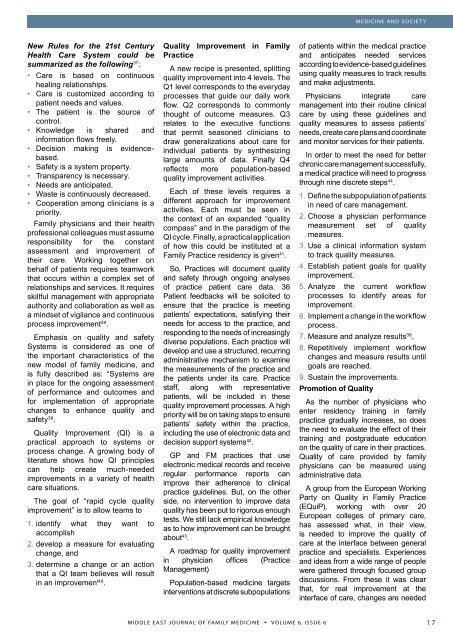full pdf of issue - Middle East Journal of Family Medicine
full pdf of issue - Middle East Journal of Family Medicine
full pdf of issue - Middle East Journal of Family Medicine
You also want an ePaper? Increase the reach of your titles
YUMPU automatically turns print PDFs into web optimized ePapers that Google loves.
MEDICINE AND SOCIET YNew Rules for the 21st CenturyHealth Care System could besummarized as the following 37 :••••••••••Care is based on continuoushealing relationships.Care is customized according topatient needs and values.The patient is the source <strong>of</strong>control.Knowledge is shared andinformation flows freely.Decision making is evidencebased.Safety is a system property.Transparency is necessary.Needs are anticipated.Waste is continuously decreased.Cooperation among clinicians is apriority.<strong>Family</strong> physicians and their healthpr<strong>of</strong>essional colleagues must assumeresponsibility for the constantassessment and improvement <strong>of</strong>their care. Working together onbehalf <strong>of</strong> patients requires teamworkthat occurs within a complex set <strong>of</strong>relationships and services. It requiresskillful management with appropriateauthority and collaboration as well asa mindset <strong>of</strong> vigilance and continuousprocess improvement 39 .Emphasis on quality and safetySystems is considered as one <strong>of</strong>the important characteristics <strong>of</strong> thenew model <strong>of</strong> family medicine, andis <strong>full</strong>y described as: “Systems arein place for the ongoing assessment<strong>of</strong> performance and outcomes andfor implementation <strong>of</strong> appropriatechanges to enhance quality andsafety 38 .Quality Improvement (QI) is apractical approach to systems orprocess change. A growing body <strong>of</strong>literature shows how QI principlescan help create much-neededimprovements in a variety <strong>of</strong> healthcare situations.The goal <strong>of</strong> “rapid cycle qualityimprovement” is to allow teams to1.2.3.identify what they want toaccomplishdevelop a measure for evaluatingchange, anddetermine a change or an actionthat a QI team believes will resultin an improvemen t40 .Quality Improvement in <strong>Family</strong>PracticeA new recipe is presented, splittingquality improvement into 4 levels. TheQ1 level corresponds to the everydayprocesses that guide our daily workflow. Q2 corresponds to commonlythought <strong>of</strong> outcome measures. Q3relates to the executive functionsthat permit seasoned clinicians todraw generalizations about care forindividual patients by synthesizinglarge amounts <strong>of</strong> data. Finally Q4reflects more population-basedquality improvement activities.Each <strong>of</strong> these levels requires adifferent approach for improvementactivities. Each must be seen inthe context <strong>of</strong> an expanded “qualitycompass” and in the paradigm <strong>of</strong> theQI cycle. Finally, a practical application<strong>of</strong> how this could be instituted at a<strong>Family</strong> Practice residency is given 41 .So, Practices will document qualityand safety through ongoing analyses<strong>of</strong> practice patient care data. 36Patient feedbacks will be solicited toensure that the practice is meetingpatients’ expectations, satisfying theirneeds for access to the practice, andresponding to the needs <strong>of</strong> increasinglydiverse populations. Each practice willdevelop and use a structured, recurringadministrative mechanism to examinethe measurements <strong>of</strong> the practice andthe patients under its care. Practicestaff, along with representativepatients, will be included in thesequality improvement processes. A highpriority will be on taking steps to ensurepatients’ safety within the practice,including the use <strong>of</strong> electronic data anddecision support systems 42 .GP and FM practices that useelectronic medical records and receiveregular performance reports canimprove their adherence to clinicalpractice guidelines. But, on the otherside, no intervention to improve dataquality has been put to rigorous enoughtests. We still lack empirical knowledgeas to how improvement can be broughtabout 43 .A roadmap for quality improvementin physician <strong>of</strong>fices (PracticeManagement)Population-based medicine targetsinterventions at discrete subpopulations<strong>of</strong> patients within the medical practiceand anticipates needed servicesaccording to evidence-based guidelinesusing quality measures to track resultsand make adjustments.Physicians integrate caremanagement into their routine clinicalcare by using these guidelines andquality measures to assess patients’needs, create care plans and coordinateand monitor services for their patients.In order to meet the need for betterchronic care management success<strong>full</strong>y,a medical practice will need to progressthrough nine discrete steps 44 .1.2.3.4.5.6.Define the subpopulation <strong>of</strong> patientsin need <strong>of</strong> care management.Choose a physician performancemeasurement set <strong>of</strong> qualitymeasures.Use a clinical information systemto track quality measures.Establish patient goals for qualityimprovement.Analyze the current workflowprocesses to identify areas forimprovement.Implement a change in the workflowprocess.7. Measure and analyze results 38 .8.Repetitively implement workflowchanges and measure results untilgoals are reached.9. Sustain the improvements.Promotion <strong>of</strong> QualityAs the number <strong>of</strong> physicians whoenter residency training in familypractice gradually increases, so doesthe need to evaluate the effect <strong>of</strong> theirtraining and postgraduate educationon the quality <strong>of</strong> care in their practices.Quality <strong>of</strong> care provided by familyphysicians can be measured usingadministrative data.A group from the European WorkingParty on Quality in <strong>Family</strong> Practice(EQuiP), working with over 20European colleges <strong>of</strong> primary care,has assessed what, in their view,is needed to improve the quality <strong>of</strong>care at the interface between generalpractice and specialists. Experiencesand ideas from a wide range <strong>of</strong> peoplewere gathered through focused groupdiscussions. From these it was clearthat, for real improvement at theinterface <strong>of</strong> care, changes are neededMIDDLE EAST JOURNAL OF FAMILY MEDICINE • VOLUME 6, ISSUE 6 17
















